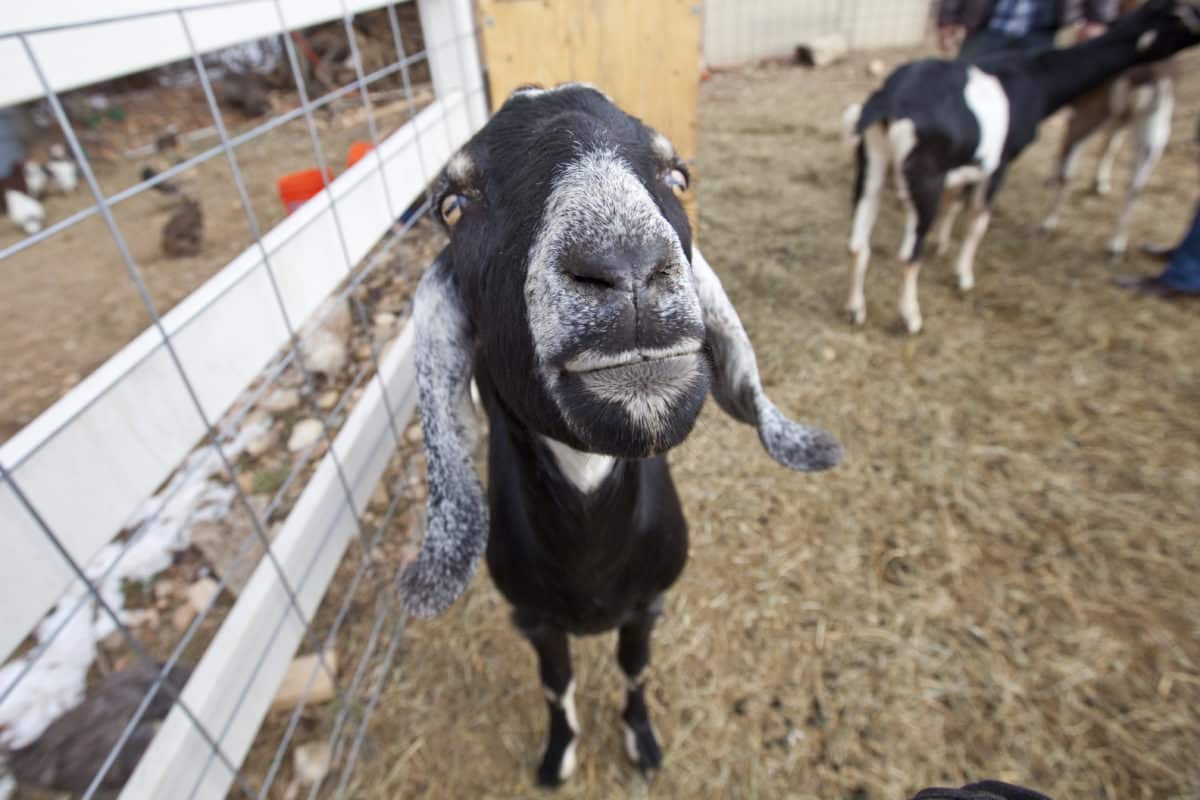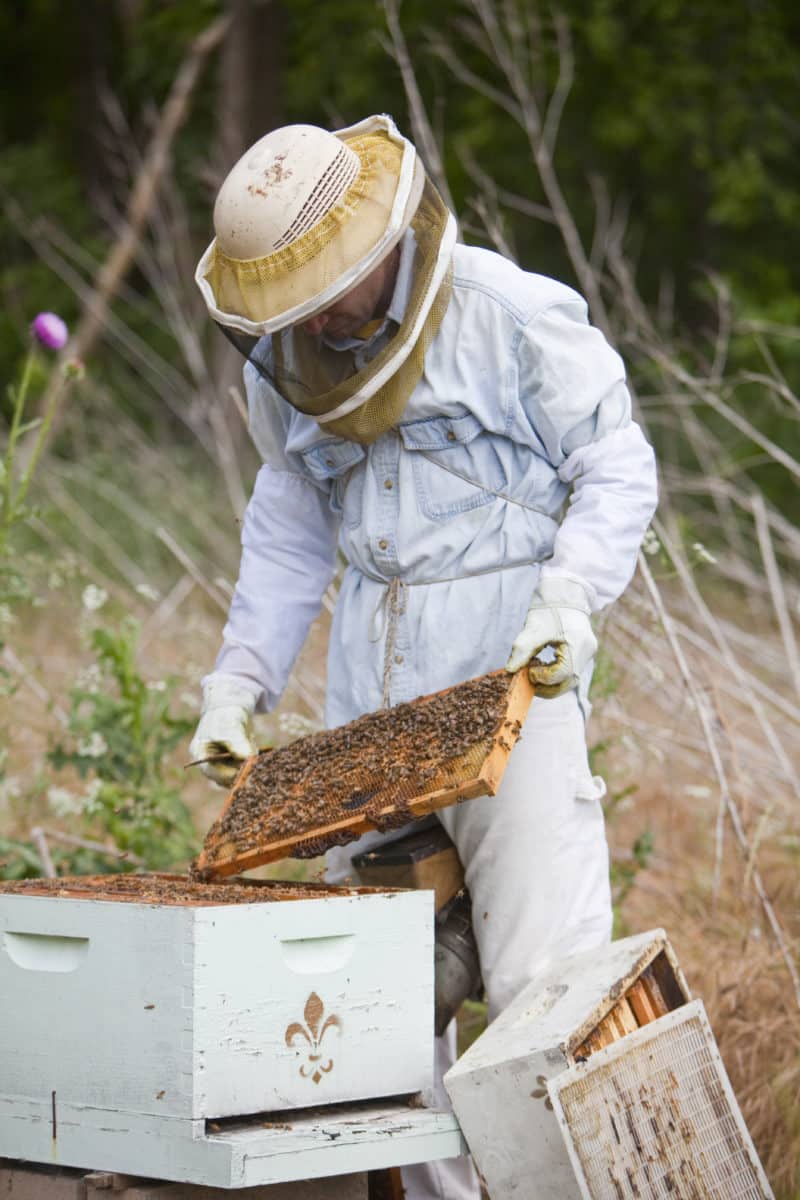Near Cañon City, Colorado, USA, Mary Provost, 56, stands in the middle of two hundred goats, a copper sun radiant above her head. “These are my ladies,” she says, affectionately rubbing a Nubian beneath its rounded chin. “My girls. We just finished the morning’s milking, so now it’s time for them to enjoy some breakfast.” She nods toward the feed bunker, where sprigs of mint-green hay overflow the ricks. “Alfalfa,” she explains, wading waist-deep through the congregation. As she holds forth a handful, the animals instantly crowd around her, begging for a bite. Mary happily obliges.
“Looks good enough to eat, doesn’t it? At least, the girls sure think so.” The goats quickly gobble up the hay, munching serenely as she dusts her hands. “And at the end of the day,” Mary adds, smiling, “that’s what really counts.”
The setting is beyond idyllic. Towering pink bluffs are sprinkled with sage brush and juniper, the southwestern canyons drenched in shadow, arroyos trailing breccia straight to the banks of the silvery Arkansas River. Surrounded by goats and barns and the expansive Rocky Mountain sky, it’s easy to forget that I’m standing in the middle of a maximum security prison, where inmates are garbed in bright orange fatigues as they go about their daily chores. For Mary, however, who supervises a crew of thirty-two prisoners, this is an everyday reality.
“Getting to work with the goats is a privilege for the inmates,” she explains. “Not a right. This is a paid position with bonuses. And the wait list, to get a job here? It’s more than a thousand long.” One of her crew drives past on a tractor, trundling a wagon of bedding straw to the barns. Mary raises her voice above the roar of the diesel.

“The milk we produce here is made into cheese by Haystack Creamery and shipped all over the country, from Los Angeles to New York.” She spreads her arms, marveling at the thought of it all. “It’s an incredible opportunity, and especially so for these boys. They’re learning a work ethic they’ll never get out on the streets. But our biggest challenge? Supply. Providing enough to meet the enormous customer demand.”
Nearly eight hundred miles away, on a four-story building’s rooftop in downtown Dallas, Brandon Pollard, 41, can surely empathize. He stands peacefully within a vortex of honeybees, two thousand wings weaving in synchronicity as he studies a wooden frame filled with amber beeswax. “My wife Susan and I, we tend to one hundred and fifty hives, scattered across fifty locations. It’s a full time job, and we’re often sold out of honey at our local farmers’ markets. There’s no doubt, this city could use more beekeepers.”
Honeybees dance around his head, and he flashes a bright smile from the shade of his mask. “But on days like this,” he adds, holding forth the frame, “all the hard work is especially sweet. Here, try a taste. The bees won’t mind.”
At his insistence, I sweep my finger through the golden comb, dripping honey the color of maple syrup. In one motion, I carry it to my mouth. My tongue recognizes floral notes of hyacinth and honeysuckle, but also the unexpected flavors of dandelion and white top clover, plants most people consider to be weeds. Brandon nods at the mention.
“Dandelions, clover, buttercups… you know, all those plants we’re taught to spray with herbicide, so we can have a ‘perfect’ lawn.” He slowly shakes his head.
“Look, we need to realize, wildflowers and weeds are prime sources of food for the bees. And for urban bees especially, they depend on this kind of forage. Without flowers, including dandelions, they can’t make honey. Who wants that?”
Agreed. Who doesn’t like honey? Or happy goats? Or, come to think of it, a thousand joyfully clucking chickens roaming the open pasture, sunning themselves in the foothills of the Blue Ridge mountain? For, implausible as it may seem, this is the daily scene at my own farm, Smith Meadows, thirteen hundred miles from the rooftops of Dallas and an hour west of Washington, DC. It’s here that I’ve been raising free-range hens for two decades, making a full-time living selling eggs at local farmers’ markets.

If this is beginning to read like a connect-the-dots type of story, as though deciphering constellations from a spray of evening stars, then you’re certainly not alone. We farmers often feel the same way. After all, with land prices at all-time highs and commodity monocultures dominating both economic and agricultural landscapes, who can blame a farmer for detouring off the conventional roadmap?
To best understand where we’re going, it’s vital to remember how far we’ve come. For instance, most of our so-called “industrial” farming operations — practices which are now widely accepted as mainstream — have only been around for the past fifty or so years. Nearly a century ago, however, long before the words ‘organic, local and sustainable’ became code language for alternative dining, my grandparents knew all about this type of agriculture. In fact, much like the
independently-minded farmers of today, they had little other choice.
My grandfather Robert was in his mid-thirties when the Great Depression hit, and he farmed successfully through years that, in hindsight, turned out to be the worst fifteen year period in our nation’s history.
Together, he and my grandmother raised cattle and sheep, and planted apple, cherry and peach trees along the sweetly rolling fields of the Shenandoah Valley. For their sixty-five year career, ‘sustainability’ wasn’t a buzzword, or a philosophical consideration. In order for them to survive, it was mandatory.
I can still remember, at age 5, riding with granddad in his beat-up Scout, bouncing across pastures to check his red and white Herefords. I’d delight as a cow wrapped her long tongue around an ear of corn, licking my fingers as she plucked the offering from my hand. Years later, after college, I returned to the same land, becoming a farmer myself. Like many things in life, what was old became new once again; though with any luck, you’ll never catch me farming in bell bottom overalls.
Despite what we’ve been taught — first as school children, then as adult consumers — our national food landscape is vastly different from the one our grandparents knew. Recent USDA statistics dispel this nostalgia, revealing the staggering truth: sixty percent of American family farms grossed less than $10,000 in 2012. On my own farm, when I took over my grandparents operation in 1996, I earnestly believed I could adopt their traditional practices of raising cattle, corn and apples, sell it on the commodity market, and be as successful as they were. My net profit after my first year? Eighteen dollars and sixteen cents. I was devastated.
Yet, given time to learn and strengthened by support from the local community, our farm gradually began to rewrite these ‘new’ rules. It seemed impossible at first, but after two decades of reimagining my grandparents’ operation, our land now produces food for more than a thousand customers each week.
So. Do I occasionally think back to the chorus of negative voices — the ones who told me early in my career that raising free-range chickens was an economic impossibility — and enjoy a good laugh? Oh, cluck yeah I do.
Best of all, our farm is not an exception. With the meteoric rise nationwide in farmers’ markets, CSAs and farm-to-table restaurants, the success of sustainable farming practices has become undeniable. Producers and consumers alike have insisted on change — fewer antibiotics, fewer caged animals, fewer synthetic sprays — and their requests are being answered.
We now realize there are thousands of farmers viably growing food – like Brandon’s rooftop honeybees and Mary’s beautiful herd of dairy goats — this way. Inspired by their incredible work, last summer I visited eighteen of these farms, weaving stories, photos and recipes into a celebration of our sustainable American landscape.
This type of farming nourishes more than just our appetites. It honors the faith of our ancestors; their wisdom renewed through a single, hand-planted seedling. Just like following an old roadmap, we know that these pioneering farmers are out there. Their stories, like the bountiful crops they produce, are simply waiting to be discovered. ![]()
